Safety: Micro or String Inverters
A safety comparison between micro inverter type and string inverter type Solar PV system
SAFETY OF SOLAR PV
Jithin Shaju
4/1/20232 min read


Choosing an inverter for your solar energy system can be categorized into two main categories: microinverters and string inverters. Both of these devices convert the direct current (DC) generated by your solar panels into alternating current (AC) that your home can use. However, their method of achieving this conversion and the degree to which they are safe to use differ.
A micro inverter is a small, individual inverter that is installed on each panel of a solar array. Essentially, each panel has its own inverter, which optimizes the panel's output and improves the system's efficiency. A string inverter, on the other hand, is a larger inverter connected to multiple panels in a string, and it converts the DC output of all the panels in the string into AC power.
When it comes to safety, there are a few key differences between these two types of inverters. Let's take a look at some of the most important factors.
Electrical Safety
One of the most important considerations when it comes to solar energy systems is electrical safety. Microinverters and string inverters are designed to be safe, but some differences in their design affect their safety.
Microinverters are generally considered to be safer than string inverters because they operate at a lower voltage. Each microinverter is responsible for converting the DC output of a single panel into AC, so the voltage that it operates at is relatively low. In contrast, string inverters are responsible for converting the DC output of multiple panels into AC, so they operate at a higher voltage. This means that there is a higher risk of electric shock or fire when working with string inverters.
In addition, microinverters are designed to shut off automatically in the event of a fault or overload. This means that if there is a problem with one panel or one microinverter, the rest of the system will continue to operate safely. With a string inverter, a fault or overload in one panel or string can affect the entire system, potentially causing damage or creating a safety hazard.
Installation Safety
The installation process for microinverters and string inverters is also different, which can affect their safety.
Microinverters are typically easier and safer to install because they are installed directly on the solar panel. This means that the wiring is shorter and there is less chance of errors or accidents during installation. In addition, because microinverters operate at a lower voltage, there is less risk of electric shock during installation.
String inverters, on the other hand, require more wiring and are typically installed in a separate location from the solar panels. This means there is a higher risk of errors or accidents during installation, and more exposed wiring may pose a safety hazard. In addition, because string inverters operate at a higher voltage, there is a higher risk of electric shock during installation.
Maintenance Safety
Finally, maintenance is an important aspect of solar energy systems, and the safety of the inverter during maintenance is an important consideration.
Microinverters are typically easier and safer to maintain because they are installed directly on the solar panel. This means that they have to be installed in easily accessible way and can be replaced or repaired without much effort. In addition, because each microinverter operates independently, there is less risk of affecting the entire system during maintenance.
String inverters, on the other hand, require more maintenance because they are responsible for converting the DC output of multiple panels. This means that they may need to be replaced or repaired more frequently, and the maintenance process can be more complex. In addition, because string inverters operate at a higher voltage, there is a higher risk of electric shock during maintenance.
